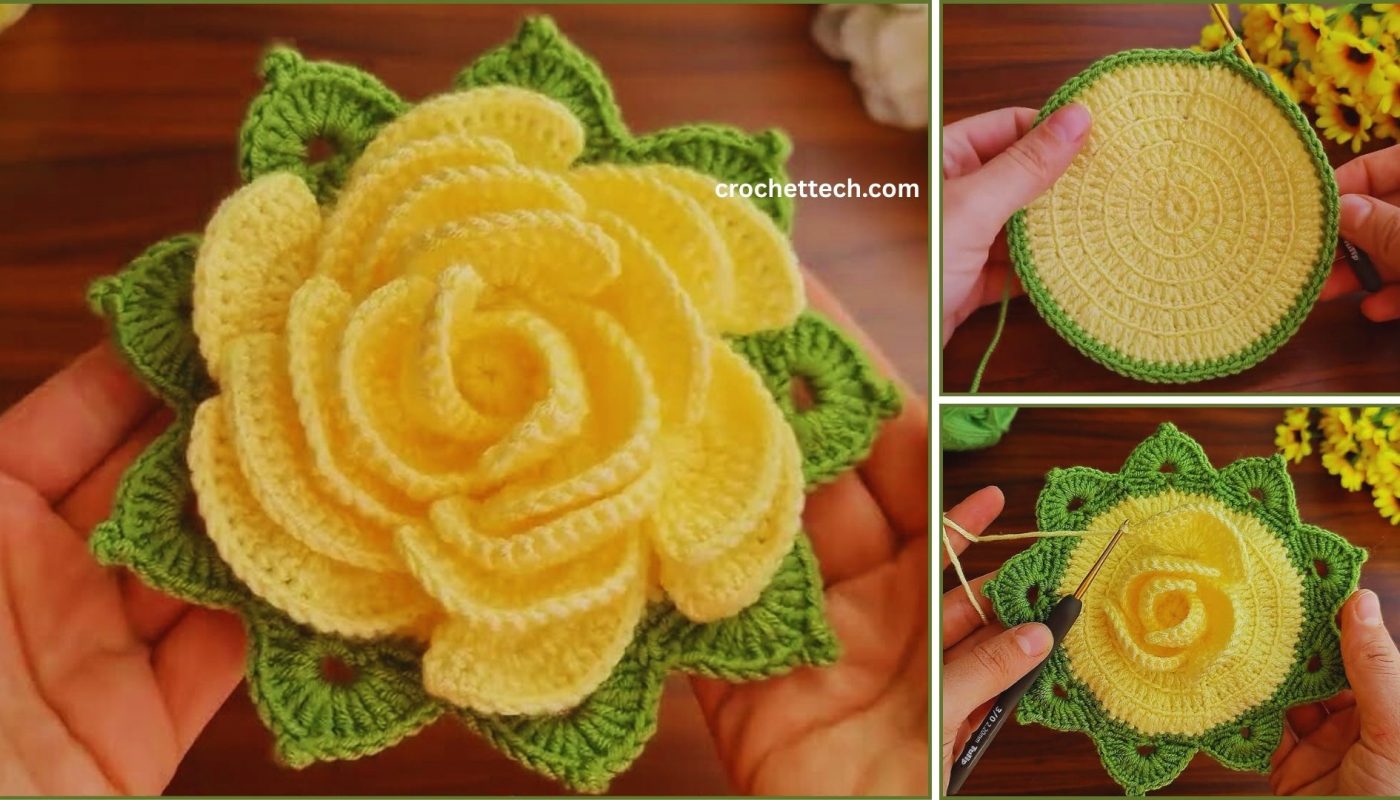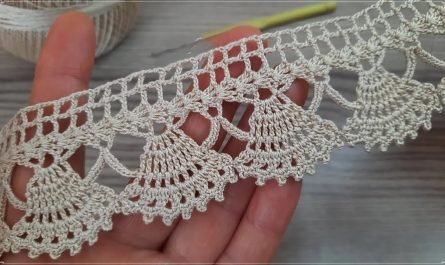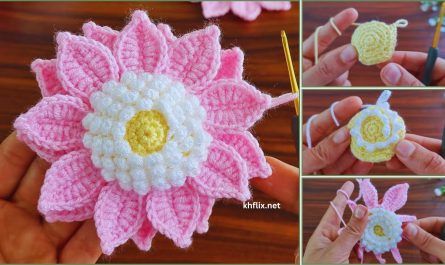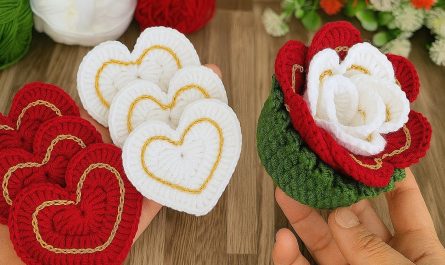Let’s crochet a truly charming and natural-looking crochet leaf rose flower! As a beginner, this project is a wonderful way to learn how different stitch heights can create beautiful 3D effects and how to assemble multiple crocheted pieces into one cohesive design. You’ll be amazed at how simple it is to bring this lovely bloom to life.
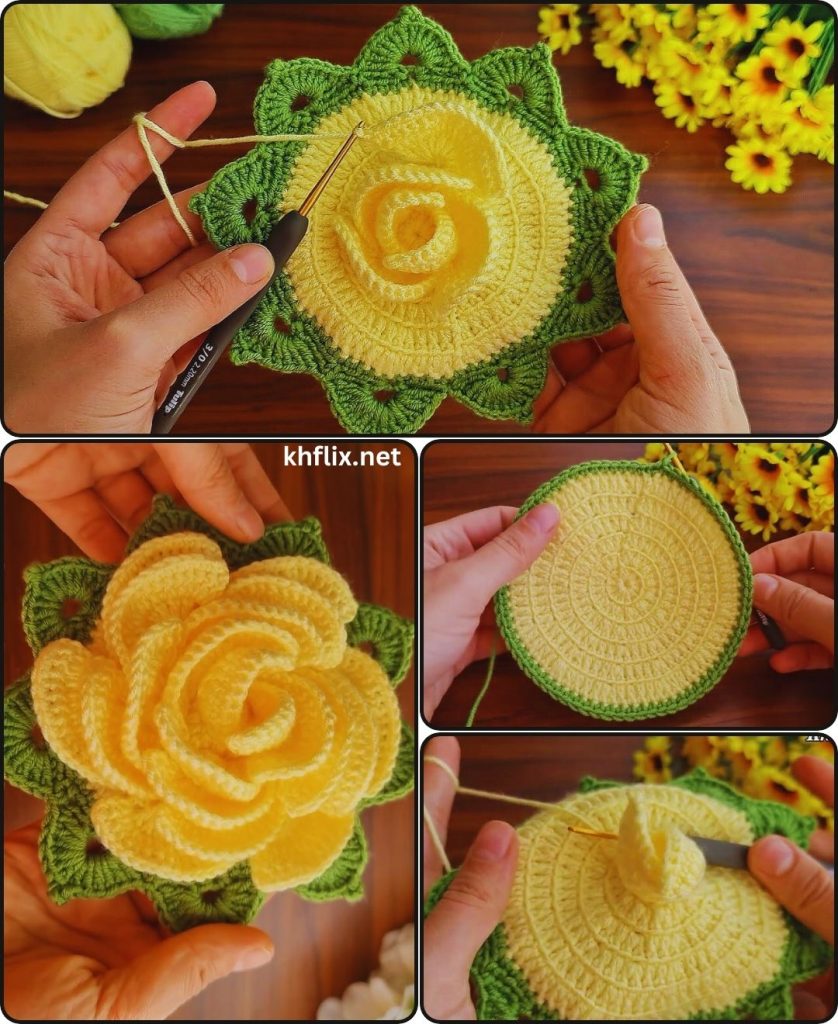
How to Crochet a Leaf Rose Flower: A Detailed Beginner’s Guide
This comprehensive tutorial will walk you through crafting a beautiful, spiraled rose and its accompanying realistic leaves. We’ll break down each step using only beginner-friendly stitches, showing you how to create both components and then assemble them into a delightful, finished flower that’s perfect for embellishing blankets, hats, bags, or as a charming standalone decoration.
Skill Level: Beginner
This project is perfectly suited for you if you’re comfortable with (or ready to learn!):
- Holding your hook and yarn: The fundamental grip.
- Making a slip knot: The starting point for most crochet projects.
- Chain (ch): The most basic stitch, forming your foundation.
- Slip Stitch (sl st): Used for joining rows/rounds and neatening ends.
- Single Crochet (sc): A short, dense stitch, great for sturdy fabric.
- Half Double Crochet (hdc): An intermediate stitch, taller than sc and works up quickly.
- Double Crochet (dc): A taller stitch, creating a more open and flexible fabric.
- Working in rows: Crocheting back and forth across your work.
- Weaving in ends: The essential finishing touch for a clean look.
Finished Flower Dimensions (Approximate):
Using worsted weight yarn and the suggested hook, your finished leaf rose will typically be about 3 to 4.5 inches (7.5 to 11.5 cm) in diameter and 1.5 to 2 inches (4 to 5 cm) tall. The exact size will vary a bit depending on your personal tension and how snugly you roll your rose.
Materials You’ll Need:
Gathering your materials before you start makes the process smoother and more enjoyable.
- Yarn: Small amounts of Worsted Weight (Medium #4) Yarn.
- Color A (Rose Petals): Approximately 15-25 yards (14-23 meters). Choose your favorite rose color: classic red, soft pink, elegant white, cheerful yellow, or even a unique lavender. Acrylic yarn is excellent for beginners – it’s smooth, affordable, and easy to work with.
- Color B (Leaves): A small amount (5-10 yards) of Worsted Weight (Medium #4) Yarn in Green. Pick a shade of green that complements your rose color.
- Crochet Hook: Size H/5.0mm. This hook size is a versatile choice for worsted weight yarn. It creates a fabric that’s dense enough to hold the rose’s shape but still flexible enough to roll and form beautiful petals.
- Yarn Needle (Tapestry Needle): This is absolutely essential for the final step of sewing your rose together and weaving in all your ends. It has a blunt tip and a large eye, making it easy to thread yarn through.
- Scissors: Any pair of sharp scissors will do for cutting your yarn.
Understanding the Flower Construction: A Two-Part Harmony
This beautiful leaf rose is created in two main parts, which are then assembled to form the complete flower. This makes the process less intimidating for beginners.
- Rose Petal Strip: You’ll crochet one long, flat strip. This strip is designed with sections of gradually increasing stitch heights. When you roll this strip, the taller sections naturally flare out, forming the layers of petals, while the shorter sections create the tighter inner bud.
- Leaves: You’ll crochet individual leaf shapes separately. These are simple to make and add a realistic touch to your rose.
- Assembly: The crocheted rose strip is gently rolled and securely stitched at its base. Then, the crocheted leaves are strategically attached to the rose’s base, completing your flower.
Let’s Crochet Your Leaf Rose Flower!
Follow these steps carefully, and don’t be afraid to take your time. Practice makes perfect, and you’ll soon see your beautiful flower emerge.
Part 1: Crocheting the Rose Petal Strip (Color A)
This long strip is the heart of your rose. The length of your initial chain directly influences how large and full your finished rose will be.

- Starting Chain:
- Begin by making a slip knot with your rose color yarn (Color A) and placing it onto your H/5.0mm crochet hook.
- Chain (ch) 40. This is a good length for a medium-sized rose.
- For a slightly smaller rose: Chain 30-35.
- For a larger, fuller rose: Chain 50-60.
- Count your chains carefully! It’s easy to lose count, so you might want to count them twice.
- Row 1 (Foundation Row – Single Crochet):
- We’ll start by making a row of single crochet (sc) stitches into your chain. This creates a sturdy, dense base for your petals.
- Insert your hook into the 2nd chain from your hook. (Don’t count the loop directly on your hook; count the first actual chain stitch after that.)
- Yarn over (wrap the yarn from back to front over your hook).
- Pull the yarn through the chain stitch (you now have 2 loops on your hook).
- Yarn over again.
- Pull the yarn through both loops on your hook. Congratulations, you’ve made your first single crochet (sc)!
- Continue to work 1 sc into each remaining chain across the entire row. You should end up with a total of 39 single crochet stitches.
- Once you’ve reached the end of the row, chain 1 (ch 1). This chain 1 acts as a “turning chain” and gives you the necessary height to start the next row.
- Turn your work. This means flipping your crochet piece over, like turning a page in a book, so your hook is ready to work into the first stitch of the new row.
- Row 2 (Smallest Petals / Inner Layer – Single Crochet & Chain 1):
- This row starts creating the texture for your inner, tighter petals.
- Work (1 sc, ch 1) into the first single crochet stitch of the previous row. (This means you’ll make one sc stitch, then chain one, all into the very first stitch space.)
- Now, skip the next single crochet stitch.
- Work (1 sc, ch 1) into the single crochet stitch after the one you skipped.
- Repeat this pattern: * Skip 1 sc. Work (1 sc, ch 1) into the next sc. *
- Continue repeating from * to * across the entire row. You’ll end up with approximately 20 (sc, ch 1) pairs.
- At the end of the row, chain 2 (ch 2). This chain 2 will give you the necessary height for the next row and counts as the starting half double crochet (hdc) of the next row.
- Turn your work.
- Row 3 (Medium Petals – Half Double Crochet & Chain 1):
- This row builds slightly taller petals, adding to the rose’s fullness.
- You’ll be working into the chain 1 spaces from the previous row. These are the little gaps created by your “ch 1” stitches.
- Work (2 half double crochet (hdc), ch 1) into the first chain 1 space from the previous row. (To make an hdc: Yarn over, insert hook into the chain 1 space, yarn over, pull up a loop [you now have 3 loops on your hook], yarn over, pull through all 3 loops on your hook. Make two of these, then ch 1.)
- *Work (2 hdc, ch 1) into the next chain 1 space.*
- Repeat from * to * across the entire row.
- You’ll have 20 (2hdc, ch 1) groups.
- At the end of the row, chain 3 (ch 3). This chain 3 gives you the necessary height for the next row and counts as the starting double crochet (dc) of the next row.
- Turn your work.
- Row 4 (Largest Petals / Outer Layer – Double Crochet & Chain 1):
- This final row creates the largest, most prominent petals, which will form the outermost layers of your rose.
- You’ll continue working into the chain 1 spaces from the previous row.
- Work (3 double crochet (dc), ch 1) into the first chain 1 space from the previous row. (To make a dc: Yarn over, insert hook into the chain 1 space, yarn over, pull up a loop [you now have 3 loops on your hook], yarn over, pull through 2 loops, yarn over, pull through the remaining 2 loops. Make three of these, then ch 1.)
- *Work (3 dc, ch 1) into the next chain 1 space.*
- Repeat from * to * across the entire row.
- You’ll have 20 (3dc, ch 1) groups.
- Fasten off your yarn (Color A). Cut the yarn, leaving a very long tail (at least 24-30 inches / 60-75 cm). Pull this long tail completely through the loop left on your hook and gently tug to secure the knot. This long tail is absolutely crucial for sewing your rose together later!
Part 2: Crocheting the Leaves (Color B)
You’ll make two or three individual leaves to accompany your rose. These are simple, symmetrical shapes.
- Leaf Pattern (Repeat for 2-3 leaves):
- With your green yarn (Color B), make a slip knot and place it on your hook.
- Chain (ch) 8. This will be the central “vein” of your leaf.
- Now, you’ll work down one side of the chain, then turn and work down the other side to create the leaf shape.
- Side 1 of Leaf:
- Work 1 sc into the 2nd chain from your hook.
- Work 1 hdc into the next chain.
- Work 1 dc into the next 2 chains.
- Work 1 hdc into the next chain.
- Work 1 sc into the last chain.
- Turning the Corner & Side 2 of Leaf:
- At the end of the last sc, chain 2 (ch 2). This creates a little point for your leaf and gets you ready to turn.
- Now, rotate your work. You’ll be working into the unused loops on the opposite side of your starting chain.
- Work 1 sc into the very first stitch (the same chain where you made the last sc on Side 1).
- Work 1 hdc into the next hdc (from Side 1).
- Work 1 dc into the next 2 dc (from Side 1).
- Work 1 hdc into the next hdc (from Side 1).
- Work 1 sc into the last sc (from Side 1).
- Join and Finish Leaf:
- Slip stitch (sl st) into the first sc you made at the beginning of the leaf to join the round and close the leaf shape.
- Fasten off, leaving a tail about 8-10 inches (20-25 cm) long for sewing.
- Make 2 to 3 more of these small leaf shapes.
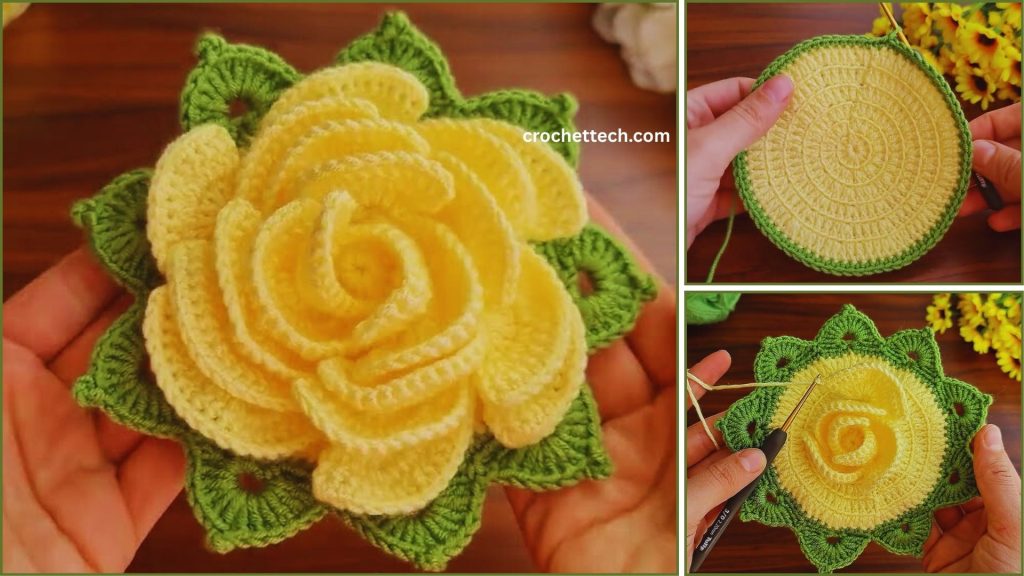
Part 3: Assembling Your Leaf Rose Flower
This is where your individual crocheted components come together to form the complete, beautiful flower.
- Roll and Shape the Rose:
- Take the end of your crocheted rose strip that has the smallest petals (the sc row, from where you started your initial chain). This will be the tight center bud of your rose.
- Begin to roll this end tightly inwards a few times with your fingers, forming a small, snug cylinder. This forms the very core of your rose.
- As you continue to roll the rest of the strip, begin to slightly angle it downwards and outwards. This allows the subsequent rows (the hdc and dc rows, which are taller) to naturally flare out and overlap, creating the beautiful spiral effect of rose petals.
- Let the crocheted fabric and the petals overlap naturally as you roll. Don’t pull too tightly on the rolling; allow the petals to sit somewhat loosely and gracefully, mimicking the way real rose petals unfurl. Guide them with your fingers to ensure they form a pleasing, continuous spiral.
- Once you’ve rolled the entire strip into your desired rose shape, you can use a few sewing pins (dressmaker pins) to temporarily hold the base of the rose together. Stick the pins through the layers at the bottom to keep them from unraveling while you prepare to sew.
- Sew the Rose Base Securely:
- Thread the very long Color A tail you left from the rose strip onto your yarn needle.
- Starting from the very center of the rose’s base (the underside of the rolled flower), pass your yarn needle repeatedly through all layers of the rolled fabric. Imagine you’re stitching back and forth across the “bottom” or “back” of the rose.
- Be meticulous and thorough: Make multiple stitches, going from one side of the base to the other, ensuring you catch every single layer of the rolled strip with your needle. This is vital to secure the spiral and prevent it from unraveling over time.
- Aim to create strong, tight stitches at the base that are not visible from the front (top) of the rose.
- Work your way back and forth across the entire base several times until it feels very sturdy and completely secure. Don’t skimp on this step!
- As you sew, you can gently adjust and shape the petals with your fingers, fluffing them out slightly if desired.
- Attach the Leaves:
- Position your crocheted leaves at the base of your rose, arranging them to your liking (e.g., two leaves slightly overlapping at the back, or three spaced evenly around the bottom).
- Using your yarn needle and the tails from the leaves, carefully sew each leaf onto the underside of the rose’s base. Pass the needle through a part of the leaf and into the rose’s base, securing it firmly with several stitches.
- Ensure the leaves are firmly attached and lie flat against the base or subtly curve, creating a natural look.
Final Touches:
- Weave in ALL Remaining Ends:
- This is the final, crucial step for a neat, durable flower. You’ll have several tails from your starting chain, from where you fastened off the rose, and from each leaf. Use your yarn needle to meticulously weave in every single loose yarn tail.
- How to Weave Neatly: Weave the tails into the stitches of the same color as the tail. Go back and forth through the stitches for at least 1.5-2 inches (4-5 cm), making sure to pass through the fibers of the yarn to secure it. Subtly change direction at least once (e.g., weave along a row, then weave back through some of the same stitches diagonally or perpendicularly) to “lock” the tail in place and prevent it from unraveling. Trim any excess yarn close to the fabric.
- Gently Shape and Admire:
- With your fingers, gently fluff and adjust the petals and leaves to achieve your desired rose shape. You can subtly curl individual petals outwards or inwards to create a more organic and natural look.
- Step back and admire your beautiful, handmade leaf rose flower!
Congratulations! You’ve successfully crocheted a beautiful leaf rose flower as a beginner! This charming and realistic bloom is now ready to add a touch of handmade elegance to blankets, hats, bags, headbands, or simply brighten a space as a lovely decorative piece.
What creative project are you excited to use your beautiful new leaf rose on?

